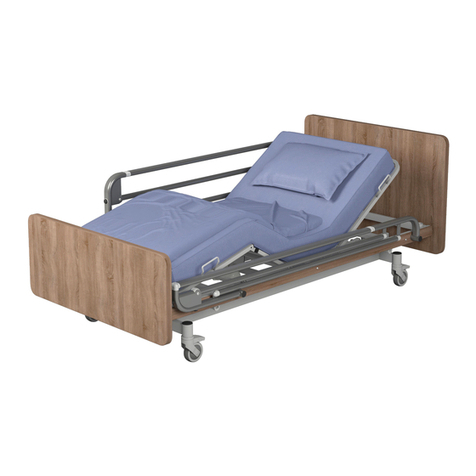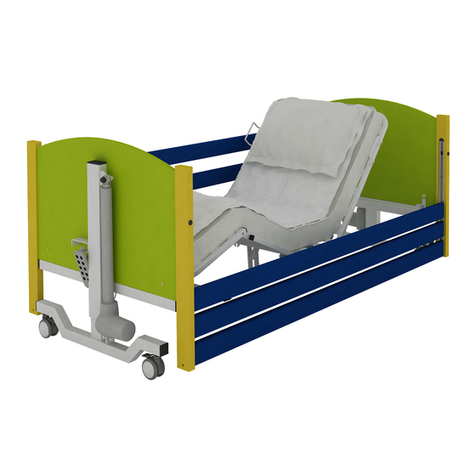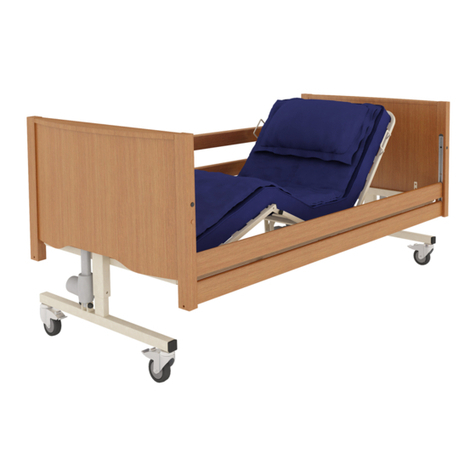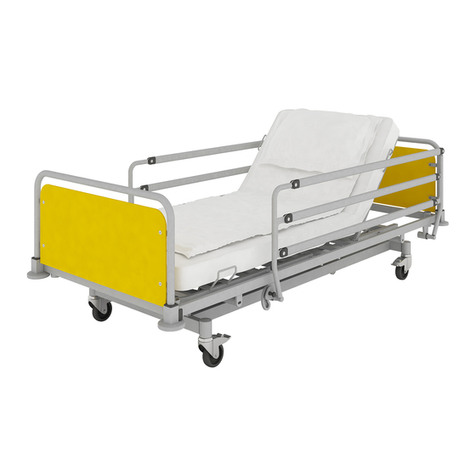3
CONTENTS
1. INTRODUCTION ....................................... 4
1.1. CONTACT........................................... 4
1.2. TO WHAT IT CONCERNS? ...................... 4
1.3. FEATURES.......................................... 4
1.4. USE .................................................. 5
1.5. CONTRAINDICATIONS........................... 5
2. WARNINGS AND CAUTIONS.................... 7
2.1. GENERAL WARNINGS ........................... 7
3. TRANSPORT AND STORAGE .................. 10
4. SYMBOL DEFINITIONS ........................... 12
5. PARTS .................................................... 14
5.1. PARTS SPECIFICATION ........................ 14
6. BED ASSEMBLY AND PREPARING FOR USE
................................................................... 15
6.1. ASSEMBLING THE MATTRESS PLATFORM 15
6.2. ASSEMBLING THE WOODEN BED ENDS .. 16
6.3. FITTING THE WOODEN,FULL-LENGTH SIDE
RAILS............................................................ 16
6.1. ASSEMBLING THE MEDICAL BED END ..... 18
6.2. FITTING THE MEDICAL SIDE RAILS ......... 18
6.3. CHECKING THE BED............................ 19
7. TRAINING............................................... 20
8. FIRST USE............................................... 21
8.1. OPERATIONAL LIMITS......................... 21
8.2. GENERAL SAFETY............................... 21
8.3. PREPARING FOR START....................... 22
8.4. BRAKE SYSTEM..................................23
8.5. SIDE RAILS AND MATTRESSES ...............23
8.5.1. MATTRESS THICKNESS ..............24
8.5.2. OPERATING THE WOODEN,FULL-
LENGTH SIDE RAILS..........................................24
8.5.3. OPERATING THE MEDICAL SIDE
RAILS............................................................24
8.6. EMERGENCY PULLING-OUT OF THE BED
END..............................................................25
8.7. OPERATING THE BACKREST SECTION......26
8.8. LEG SECTION.....................................26
9. DISASSEMBLING THE BED FOR
TRANSPORT ...............................................28
10. DECONTAMINATION............................ 30
11. MAINTENANCE .................................... 32
11.1. GENERAL MAINTENANCE..................32
11.2. SERVICE LIFE...................................33
11.3. FAULTY FINDING..............................34
12. DISPOSAL OF PARTS ............................35
13. SPECIFICATION.....................................36
13.1. BED DATA ......................................36
13.2. MAXIMUM LOAD ............................36
13.3. TECHNICAL DATA OF SIDE RAILS..........36
14. ACCESSORIES ....................................... 38
14.1. MATTRESS AND SIDE RAILS ................38
14.2. LIFTING POLE ..................................40
15. WARRANTY ..........................................42
15.1. WARRANTY CONDITIONS ..................42

































